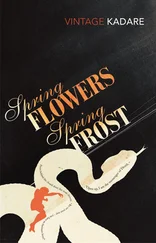The irony of this all-out chemical assault on roadsides and utility rights-of-way is twofold. It is perpetuating the problem it seeks to correct, for as experience has clearly shown, the blanket application of herbicides does not permanently control roadside “brush” and the spraying has to be repeated year after year. And as a further irony, we persist in doing this despite the fact that a perfectly sound method of selective spraying is known, which can achieve long-term vegetational control and eliminate repeated spraying in most types of vegetation.
The object of brush control along roads and rights-of-way is not to sweep the land clear of everything but grass; it is, rather, to eliminate plants ultimately tall enough to present an obstruction to drivers’ vision or interference with wires on rights-of-way. This means, in general, trees. Most shrubs are low enough to present no hazard; so, certainly, are ferns and wildflowers.
Selective spraying was developed by Dr. Frank Egler during a period of years at the American Museum of Natural History as director of a Committee for Brush Control Recommendations for Rights-of-Way. It took advantage of the inherent stability of nature, building on the fact that most communities of shrubs are strongly resistant to invasion by trees. By comparison, grasslands are easily invaded by tree seedlings. The object of selective spraying is not to produce grass on roadsides and rights-of-way but to eliminate the tall woody plants by direct treatment and to preserve all other vegetation. One treatment may be sufficient, with a possible follow-up for extremely resistant species; thereafter the shrubs assert control and the trees do not return. The best and cheapest controls for vegetation are not chemicals but other plants.
The method has been tested in research areas scattered throughout the eastern United States. Results show that once properly treated, an area becomes stabilized, requiring no re-spraying for at least 20 years. The spraying can often be done by men on foot, using knapsack sprayers, and having complete control over their material. Sometimes compressor pumps and material can be mounted on truck chassis, but there is no blanket spraying. Treatment is directed only to trees and any exceptionally tall shrubs that must be eliminated. The integrity of the environment is thereby preserved, the enormous value of the wildlife habitat remains intact, and the beauty of shrub and fern and wildflower has not been sacrificed.
Here and there the method of vegetation management by selective spraying has been adopted. For the most part, entrenched custom dies hard and blanket spraying continues to thrive, to exact its heavy annual costs from the taxpayer, and to inflict its damage on the ecological web of life. It thrives, surely, only because the facts are not known. When taxpayers understand that the bill for spraying the town roads should come due only once a generation instead of once a year, they will surely rise up and demand a change of method.
Among the many advantages of selective spraying is the fact that it minimizes the amount of chemical applied to the landscape. There is no broadcasting of material but, rather, concentrated application to the base of the trees. The potential harm to wildlife is therefore kept to a minimum.
The most widely used herbicides are 2,4-D, 2,4,5-T, and related compounds. Whether or not these are actually toxic is a matter of controversy. People spraying their lawns with 2,4-D and becoming wet with spray have occasionally developed severe neuritis and even paralysis. Although such incidents are apparently uncommon, medical authorities advise caution in use of such compounds. Other hazards, more obscure, may also attend the use of 2,4-D. It has been shown experimentally to disturb the basic physiological process of respiration in the cell, and to imitate X-rays in damaging the chromosomes. Some very recent work indicates that reproduction of birds may be adversely affected by these and certain other herbicides at levels far below those that cause death.
Apart from any directly toxic effects, curious indirect results follow the use of certain herbicides. It has been found that animals, both wild herbivores and livestock, are sometimes strangely attracted to a plant that has been sprayed, even though it is not one of their natural foods. If a highly poisonous herbicide such as arsenic has been used, this intense desire to reach the wilting vegetation inevitably has disastrous results. Fatal results may follow, also, from less toxic herbicides if the plant itself happens to be poisonous or perhaps to possess thorns or burs. Poisonous range weeds, for example, have suddenly become attractive to livestock after spraying, and the animals have died from indulging this unnatural appetite. The literature of veterinary medicine abounds in similar examples: swine eating sprayed cockleburs with consequent severe illness, lambs eating sprayed thistles, bees poisoned by pasturing on mustard sprayed after it came into bloom. Wild cherry, the leaves of which are highly poisonous, has exerted a fatal attraction for cattle once its foliage has been sprayed with 2,4-D. Apparently the wilting that follows spraying (or cutting) makes the plant attractive. Ragwort has provided other examples. Livestock ordinarily avoid this plant unless forced to turn to it in late winter and early spring by lack of other forage. However, the animals eagerly feed on it after its foliage has been sprayed with 2,4-D.
The explanation of this peculiar behavior sometimes appears to he in the changes which the chemical brings about in the metabolism of the plant itself. There is temporarily a marked increase in sugar content, making the plant more attractive to many animals.
Another curious effect of 2,4-D has important effects for livestock, wildlife, and apparently for men as well. Experiments carried out about a decade ago showed that after treatment with this chemical there is a sharp increase in the nitrate content of corn and of sugar beets. The same effect was suspected in sorghum, sunflower, spiderwort, lambs quarters, pigweed, and smartweed. Some of these are normally ignored by cattle, but are eaten with relish after treatment with 2,4-D. A number of deaths among cattle have been traced to sprayed weeds, according to some agricultural specialists. The danger lies in the increase in nitrates, for the peculiar physiology of the ruminant at once poses a critical problem. Most such animals have a digestive system of extraordinary complexity, including a stomach divided into four chambers. The digestion of cellulose is accomplished through the action of microorganisms (rumen bacteria) in one of the chambers. When the animal feeds on vegetation containing an abnormally high level of nitrates, the microorganisms in the rumen act on the nitrates to change them into highly toxic nitrites. Thereafter a fatal chain of events ensues: the nitrites act on the blood pigment to form a chocolate-brown substance in which the oxygen is so firmly held that it cannot take part in respiration, hence oxygen is not transferred from the lungs to the tissues. Death occurs within a few hours from anoxia, or lack of oxygen. The various reports of livestock losses after grazing on certain weeds treated with 2,4-D therefore have a logical explanation. The same danger exists for wild animals belonging to the group of ruminants, such as deer, antelope, sheep, and goats.
Although various factors (such as exceptionally dry weather) can cause an increase in nitrate content, the effect of the soaring sales and applications of 2,4-D cannot be ignored. The situation was considered important enough by the University of Wisconsin Agricultural Experiment Station to justify a warning in 1957 that “plants killed by 2,4-D may contain large amounts of nitrate.” The hazard extends to human beings as well as animals and may help to explain the recent mysterious increase in “silo deaths.” When corn, oats, or sorghum containing large amounts of nitrates are ensiled they release poisonous nitrogen oxide gases, creating a deadly hazard to anyone entering the silo. Only a few breaths of one of these gases can cause a diffuse chemical pneumonia. In a series of such cases studied by the University of Minnesota Medical School all but one terminated fatally.
Читать дальше












